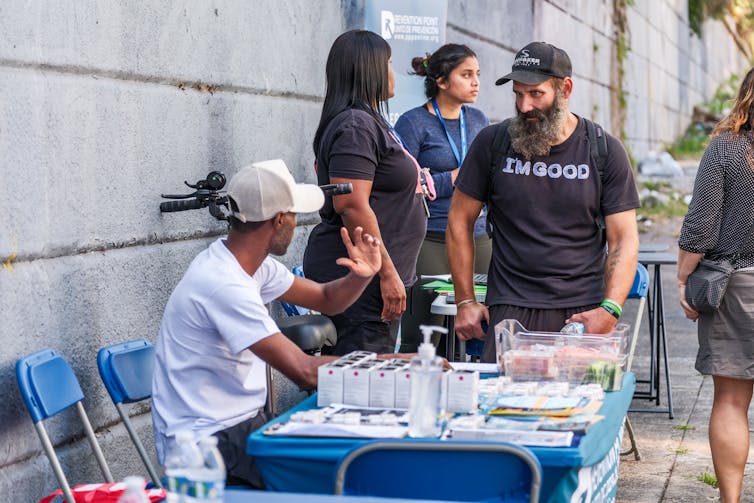
A mobile team offering medication treatment to people with opioid use disorder showed promise in getting patients in Philadelphia to return for follow-up visits, according to a peer-reviewed study I co-authored that was released in the September 2024 issue of the Journal of Substance Use and Addiction Treatment.
The team, which includes a physician, case manager and outreach workers who have personal experiences with substance use disorder, worked out of a van parked at six sites in neighborhoods that have high rates of fatal and nonfatal overdoses. The goal was to get patients same-day prescriptions for buprenorphine, a lifesaving medication that treats opioid use disorder. The van is operated by Prevention Point Philadelphia, a nonprofit, harm-reduction group that serves people experiencing homelessness and substance use disorder.
Importantly, the “bupe bus,” as patients and staff call it, reached a diverse group of patients. Nearly 60% were Black and 15% were Hispanic during the period we collected our data. Most did not have a primary care doctor or mental health providers.
After their initial visit, 86% of patients completed at least one follow-up visit, and 69% completed four or more visits on the van.
When it came to linking patients to more traditional brick-and-mortar programs, such as outpatient addiction treatment programs or buprenorphine prescribed in primary care settings, success was lower. Half of patients made it to at least one outside appointment for a buprenorphine prescription, and 30% made it to two or more visits at more traditional clinic sites.

Why it matters
As an addiction medicine physician and researcher, I think a lot about how to get effective treatment to the patients who need it most.
Philadelphia has the highest overdose death rate among large U.S. cities. The majority of people with opioid use disorder – both in Philadelphia and nationally – do not receive treatment. Also, there are persistent racial disparities in treatment, with Black and Hispanic patients less likely to receive medication treatment for opioid use disorder. Overdose deaths among Black Philadelphians have surpassed those of white residents in recent years.
The most effective treatment for opioid use disorder is medication, specifically methadone and buprenorphine, which is often known by its brand name Suboxone. These medications prevent withdrawal symptoms, manage cravings for opioids and lower the risk of overdose if someone relapses. Essentially, these medicines break the disruptive cycle of addiction, allowing people to feel normal and focus on the rest of their life.
What other research is being done
A large body of research describes barriers to addiction care. These include obstacles to obtaining health insurance coverage, regulations that limit where treatment can be provided and a lack of trained treatment providers.
Additionally, many patients don’t know where to go for addiction treatment, feel poorly treated when they do get there, or are subjected to rigid and cumbersome requirements in order to receive treatment. These requirements might include daily visits or regular counseling sessions that can make it hard to work, take care of children or attend to other life priorities.

How we do our work
The bupe bus is what’s called a low-barrier or low-threshold model. Low-barrier models aim to bring treatment directly to people who need it without imposing extra red tape. This approach is based on evidence that people are more likely to stick with medications for opioid use disorder if they can access them rapidly, and that these medicines are effective without intensive counseling or other requirements and whether or not people are abstinent from drugs.
This approach is consistent with the way health care providers treat other conditions such as diabetes or high blood pressure. However, it is less common in substance use care.
The Research Brief is a short take on interesting academic work.
Margaret Lowenstein previously worked as a clinician with Prevention Point Philadelphia's mobile overdose response unit. She receives funding from the National Institute on Drug Abuse and the Pew Charitable Trusts.
This article was originally published on The Conversation. Read the original article.







